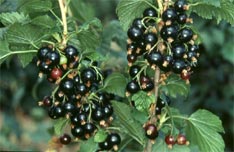The black currant is the edible berry of a shrub, which usually grows to 1-2 meters and can be found in Northern/Central Europe and Asia. The plant’s scientific name is Ribes Nigrum (which means “black ribes”)
The berry has a 1cm diameter, has a black color, a calyx at the top and a rather glossy skin, and it contains several seeds. Black currants are often used in the kitchen because of their astringent taste, which adds flavor to many dishes and beverages: for example, its leaves are used in Russia to improve the taste and color of Vodka, and it is also common in the UK, where it is mixed with cider to form “Cider and Black”.
Black currants are also added to beer (Guinness), and some beer lovers think it actually makes the taste more enjoyable
Black currants have a very high content in antioxidants and vitamins. In particular, they’re very rich in Vitamin C (and for this reason they were used in the UK during World War II, because other foods rich in Vitamin C, such as oranges, were nearly impossible to find). Black currants also contain several rare nutrients, like GLA ( Gamma Linoleic Acid, a very rare Omega-6 essential fatty acid) and MAOI (Monoamine Oxidase Inhibitors), and may therefore be used in therapies against depression. You can find out more in our black currant nutritional facts page
The taste of black currants is very sweet and sharp, and they’re used to make blackcurrant jellies, jams, added to desserts or as a part of sauces and dippings. Blackcurrants are commonly used to make cordial, liqueur, ice-cream and they can also be found in juice form
Please refer to our black currant articles for more detail and if you enjoy the website, please add it to your bookmarks for future reference!

